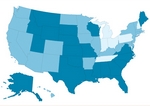AMA House of Delegates

The National Health Insurer Report Card provides actionable data that are "not just a gotcha, but a win-win for the national payers and for the AMA," says Nancy Nielsen, MD, PhD, then AMA immediate past president. Photo by Peter Wynn Thompson / www.peterthompsonphoto.com
AMA meeting: Health plans process 1 in 5 claims incorrectly
■ An AMA study says inaccurate claims processing is costing physicians and insurers.
By Pamela Lewis Dolan — Posted June 28, 2010

- ANNUAL MEETING 2010
- » Our coverage
- » Print special section
- » AMA official proceedings
- » Meeting notes: Medical practice
- » External links
- » Related content
Chicago -- Nearly 20% of all claims processed by health plans have errors, costing the health care system billions each year, according to the American Medical Association's third annual National Health Insurer Report Card, released June 14 during the AMA Annual Meeting.
With about $210 billion spent on claims processing annually, the study found claims to be costly. The health care system could save $15.5 billion each year if the industry's accuracy rate improved to 100%. Each percentage point improvement would save about $777 million, the study said.
Additionally, eliminating the time spent on claims processing red tape, which has been estimated to be the equivalent of five weeks annually, would give physicians more time to spend on direct patient care.
The blame for this 20% error rate lies mostly with the complexity of the system and a lack of streamlining among payers, according to the report card, which looked at claims errors for the first time.
Different plans have different processes for filing. Many have payment rules for work done by multiple physicians or for a series of treatments that make the claims process more confusing for plans and doctors.
The more complex the pricing, the more likely the claim was to contain errors, said Mark Rieger, CEO of National Healthcare Exchange Services. The company is a Sacramento, Calif.-based compliance and denial management solutions provider that supplied most of the data used in the analysis.
The study found Coventry Health Care to have the best record when it comes to accuracy, with a rating of 88.4%. WellPoint-owned Anthem Blue Cross and Blue Shield landed on the bottom of the list with an accuracy rate of 74%. Neither Coventry nor Anthem responded to requests for comments by this article's deadline.
Nancy Nielsen, MD, PhD, then AMA Immediate Past President, said the goal is to bring claims-processing error rates to 1% by focusing on accuracy, timeliness, transparency and industry standardization.
Numerous efforts have been launched, both by the medical and payer communities, focusing on these areas, including a call by the AMA for a standard set of rules to be adopted and used by all payers.
Robert Zirkelbach, spokesman for the trade group America's Health Insurance Plans, said in a blog response to the AMA report card: "Health plans are investing in cutting-edge technologies to make it easier for providers to submit claims electronically and receive payment quickly." He pointed to a portal project, being tested by the health plans group, that will provide a one-stop shop for physicians to conduct financial transactions with all their contracted payers.
Dr. Nielsen said physicians can do their part to improve accuracy by filing timely and accurate claims the first time, and by reviewing and reconciling claims payments. Practices also should focus on implementing practice efficiencies, she said.
But the survey shows that plans also have work to do on improving consistencies that could help reduce errors. For example, when it came to the accuracy of reporting contracted fees, the survey found that plans' accuracy rates ranged from 78% to 95%. Performance varied significantly by state, ranging from 58.6% to 96.9%.
The survey also found inconsistencies when it came to denials, with rates ranging from 0.7% to 4.5%. Lack of eligibility continued to be the most common reason for denials. Insurers' response time to claims also was lacking, according to the report, which found ranges from five to 13 days.
But there also were gains made from a year ago. The study found significant improvements in pay rates matching fee schedules, as well as in insurers disclosure of allowed amounts. Most plans are approaching 100% compliance with disclosing their allowed amounts.
"I can think of no other [piece of information] more important as the one that says, 'I think I owe you this,' " Rieger said. "This is an essential field in the revenue cycle management process for the physicians to know what the contractual adjustment is."
Dr. Nielsen said the gains were possible because the report card provides actionable data that are "not just a gotcha, but a win-win for the national payers and for the AMA."
Some of the plans agreed with Dr. Nielsen, saying that the data from prior years gave them improvements to focus on for the following years.
The report card is an annual program that was launched as part of the AMA's Heal the Claims Process campaign in 2008.












